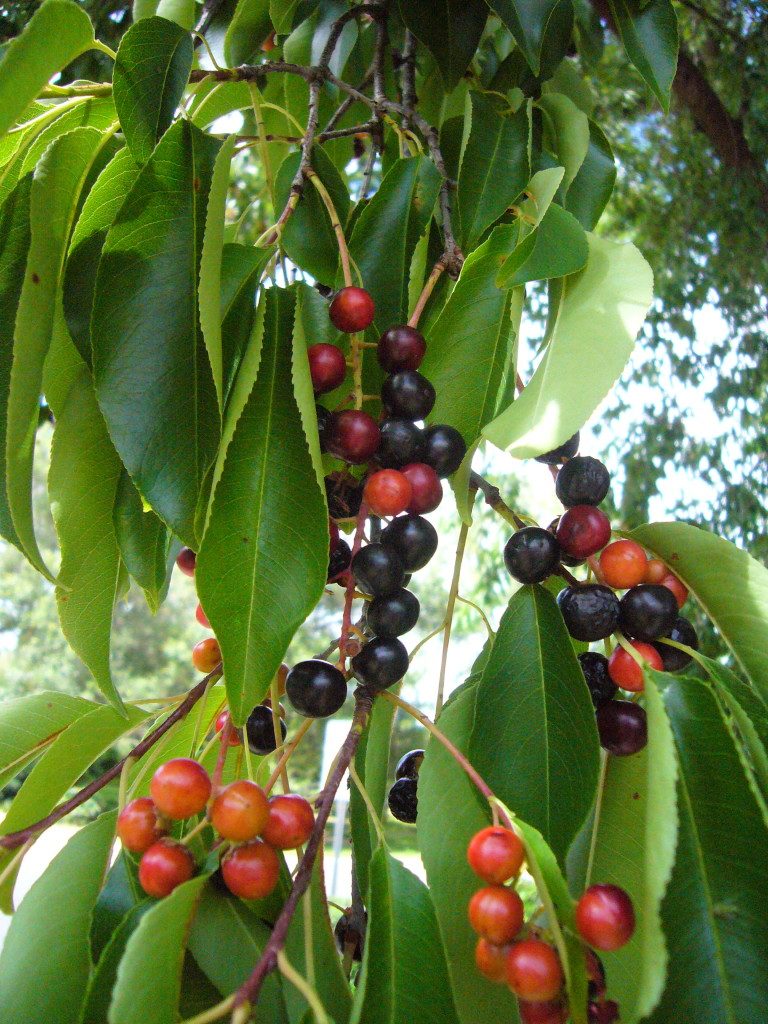
Black Cherry. Notice the leaf on the left with brown hair along the lower mid rib. Photo by Green Deane.
Black Cherries — Prunus serotina — suffer somewhat from a taste issue. When one mentions cherries most folks think of sweet cherries. And Black Cherries are sweet, but they are also bitter. They can be eaten fresh if one likes bitter. Processing, such as drying or making them into wine, reduces the bitterness.
Locally, which of this writing means central Florida, the Black Cherries are in full force, ripening and dropping fruit heavily. Like mulberries they can stain sidewalks and cars purple. A hundred and fifty miles to the north in Jacksonville the fruit is yellow, on its way to red then black. As the season progresses the wave of ripening will move north. In Pownal, Maine, where I grew up I didn’t see Black Cherries but there were plenty of choke cherries to make jelly and wine from. You could not eat those right off the tree. Well… you could try but they were very astringent. Though wild cherries are small and have a large non-edible seed, they were a significant part of many native diets.
Black Cherry were cooked then dried for winter use. Often they were smashed into small cakes before drying. The dried cherries were carried for food while hunting and the dried fruit was also ground into a flour-like material used to make soup. The cherries were eaten raw and sometimes were allowed to ferment. Most unusual for this genus, Prunus serotina twigs were used by the Chippewa to make tea.
Also just beginning to ripen locally is the Strawberry Guava. An invasive species in some areas — such as Hawaii — the leaves can be made into tea and the fruit — to some people — have a hint of strawberry flavor. This is a fruit that should be picked when mostly green but showing small splotches of red. They are still semi-hard at this stage, tart and not full of grubs. If you wait until they are totally red and ripe and sweet you will have a lot of wiggling protein in each fruit. I suppose one could control that to some extent by spraying but I’ve never put any pesticides on any of my fruit trees. If you pick the ripening fruit rather than waiting for them to totally ripen you can greatly increase the yield. To read more about the Black Cherry go here, about the Strawberry Guava, here.
Classes this week ranged from central Florida to the northeast corner of the state. In one area wild cucumbers were not to be found, but abundant in the other. But that is foraging, now and in the past. You gather what you can find. One plant we talked about in the Orlando class is Horsemint. It will be coming into season soon and is worth looking for now. A good tea and spice plant, it’s found in dry areas and will soon be showing off bright pink upper leaves. Those leaves make the plant easy to spot even when driving along the interstate. It’s the southern version of Bee Balm or Oswego Tea. You can read more about it here.
One small success this past week in Jacksonville was identifying a tree I have been pondering for quite sometime. I only saw it a few minutes every couple of months and while familiar it was always just a little off. More s0 it was a tree I expected to see more of as they are quite common in the central part of the state. My mystery tree wasn’t much of a mystery. I finally took some pictures and studied them. While I thought it might have been Basswood it is probably a mulberry. Perhaps the fact that it is growing in deep shade threw me plus only walking past it now and then. The Basswood, or Linden Tree, is also very forager friendly. You can read about it here.
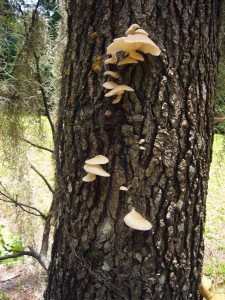
I think these are Oyster Mushrooms but I’m not sure which his why I will be studying mushrooms this weekend at the Intensive. Photo by Green Deane
I will not have a foraging class this weekend because I’ll be a student myself at a 5th Annual Mushroom Intensive in Hawthorne, Florida. It starts at 10 a.m. July 19th and ends at 5 p.m. July 20th. The location is Little Orange Creek Nature Park, 24115 SE Hawthorn Rd. Overnight camping is free. Saturday’s classes are for beginners and Sunday’s classes are more advanced. There’s been a lot of rain and there are a lot of mushrooms to see. Cost is $75 for a day or $125 for the weekend. You can learn more by going to the Facebook page called 5th Annual FL Mushroom Intensive. My next classes will be July 26th and 27th, in Melbourne and Sarasota respectively. You can learn about them by going here. I will not have any classes from then until mid-August because I will be in North Carolina hiking around though I might schedule a Meet & Greet during that time in Boone, N.C. If someone can suggest a location please let me know. Most probable date will be August 9th or 10th.
Earlier this month I spent a week or so along Florida’s southwest coast staying in Ft. Myers, Naples and on Sanibel Island. The latter could easily be called Sea Grape Island, Cocoplum Island or Poison Ivy Island. The cocoplums were ripe and everywhere (as was Poison Ivy, apparently enjoying the tropical climate.) This is an area where a frost or freeze is rare so the landscape is populated with many species just not seen further north. This make foraging in Florida interesting with a temperate forest on the north end tropical vegetation on the south end. Among my sightings were the Randia aculeata, or White Indigoberry — barley edible — Foresterea segregata, a so-called wild olive or Florida Privet — not edible — and the Beach Naupaka, or Scaevola taccada whose leaves have been used as famine food. Do not eat the white berries. There were also a lot of Pond Apples growing wild, again barely edible. It’s an area I enjoy and I might look for a (very) small condo there in my retirement…
On the Green Deane Forum we post messages and pictures about foraging all year long. There’s also a UFO page, for Unidentified Flowering Objects so plants can be identified. Recent topics include: the Fifth Annual Mushroom Intensive, Grapes Are On, Oh What The Hail, Sea Purslane So Good, Mushroom ID Field Trip, Cherry Plum?, Sarsaparilla Beer, Blackberry Tea Question, Your Best And Your Kryptonite, Wild Food Crop In Danger?, Mega Mullein, Cutting Your Herbs and Survivalist Entertainment. The link to join is on the right hand side of this page.
 My foraging videos do not include alligators but they do cover dozens of edible plants in North America. The set has nine DVD. Each DVD has 15 videos for 135 in all. Some of these videos are of better quality than my free ones on the Internet. They are the same videos but many people like to have their own copy. I burn and compile the sets myself so if you have any issues I handle it. There are no middle foragers. And I’m working on adding a tenth DVD. To learn more about the DVDs or to order them click here.
My foraging videos do not include alligators but they do cover dozens of edible plants in North America. The set has nine DVD. Each DVD has 15 videos for 135 in all. Some of these videos are of better quality than my free ones on the Internet. They are the same videos but many people like to have their own copy. I burn and compile the sets myself so if you have any issues I handle it. There are no middle foragers. And I’m working on adding a tenth DVD. To learn more about the DVDs or to order them click here.
To donate to the Green Deane Newsletter click here.

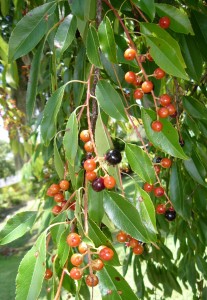
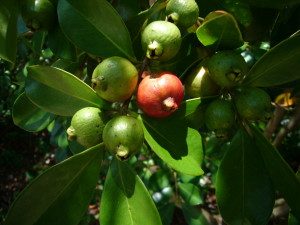
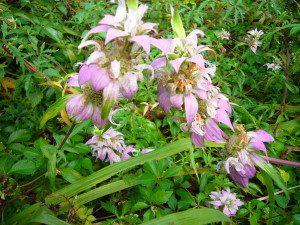
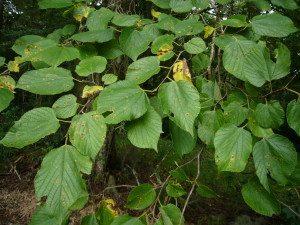
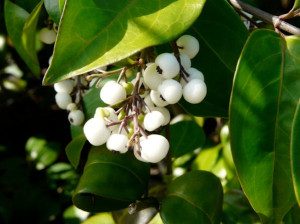


We have wild cherries all over our property and they are first putting out little green berries. It won’t be too long, however, before they ripen and start falling everywhere.
I know that the cherries are very bitter as I tried them when we first moved on the property. But you talk about the Chippewa using the twigs for tea? I was under the impression that the leaves and bark had extremely high concentrations of cyanide. Is it safe to consume them?
That’s a good question. It is reported by Moerman in his book Native American Food Plants. I was surprised by the entry myself. He was, however, a leading ethnobotanical expert and professor. I don’t think, however, I will be trying it soon myself.
Plants, even poisonous ones, when used in the right doses, can be very medicinal. Bark of black cherry and choke cherry are used in cough medicines (syrup and tinctures) as a result of their antitussive properties due, in part, to the HCN content (hydrocyanic acid) which calms the cough reflex. Stephen Buhner has a great monograph on elderberry in which he discusses its toxicity in leaves, bark, and stems, the effect of HCN on herbivores, and the ‘hysteria’ surrounding the plant. Well worth the read.
I wanted to enourage people to pick purslane. I found it growing in the local gravel parking lot where neighbors store and launch their non-gas powered boats. I have made two purslane salads. One had an Italian Vinaigrette sparingly added to the purslane leaves and assorted raw cut vegetables. I made another very similar but using traditional Greek spices and a generous sprinkling of feta cheese crumbles. I named the purslane salads Parking Lot Salad. I think they taste a bit better just knowing it’s free food.
You did find Oyster Mushrooms…they’re one of my favorites! 🙂
Deane, you ‘burn the DVDs yourself – so there is no middle forager’!!
Good one! Your sense of humor, along with your knowledge, dedication to accuracy, and the cooking tips, really sets your work apart!
Thank you!
Assuming those are oyster mushrooms and not crepedotis, they should continue to bloom there year after year you lucky fellow! Bon Apetit.
They are where I hold a class regularly in Gainesville.
One of the finest wild ice creams I’ve ever enjoyed at Nature Wonder Wild Foods Weekend in West Virginia is Wild Black Cherry Ice Cream.
Speaking of purslane, I’ve developed a quick and easy microwave bread & butter purslane pickle recipe that can be downloaded from this link: https://www.facebook.com/groups/MidwestForagers/files/
Speaking of choke cherry (one of a few species of wild cherry tree), we had them growing everywhere at the golf course last year, usually by the creek that flowed through the course. While passing by, quite a few times I would stop and pick a few, just for a nibble. When I first pop them in my mouth, I got this awesome cherry flavor, followed by the somewhat bitterness, but it wasn’t so bad. The cherry is really all seed, and just a taste of flesh around it. I later researched and seen where some folks would cut out the seeds, and put them into pan cakes. Looked good, but it’s a lot of work. I do know that most wild fruit that is bitter, is improved by cooking.
I had been waiting all year for the local blackberries to come in, and a few weeks ago, they did just that. We have a huge patch just down my road a little ways, mixed with Kudzu, which I believe is taking over the area. At least it’s one food plant taking over another I guess. If anyone has the chance, research blackberries. They say they are among the top berries that are great for us.
And last, I planted ground cherry this year in my garden. I have quite a few plants that are doing wonderful. Haven’t quite got a ripe fruit yet, but I waiting. Haven’t tasted them yet, but hoping I’ll like them.
One other note, I purchased wild lettuce seed this year, but did not get around to planting any. However, a few came up in my yard (naturally). I did not get the chance to try it, but the plants must have been good, because the deer demolished them. Oh well, good for them.
I wanted to urge everyone, that if you like wild edibles, consider growing them in your garden for your consumption, and even tossing some seed out in the wild. This way we can prevent over foraging (if the wild plants are rare in your area) as well as saving some for the wild life, and helping the plant spread. Nothing wrong with foraging at all, I love to do it. I read somewhere that certain native Americans would practice harvesting half of a fruit tree (or whatever plant), and leave the other half for the wild life. That’s great advice.
Imagine say, 400 years ago, here in America, a pristine virgin wilderness, full of life giving plants, and the people who lived here, actually respected nature. Must have been an awesome place.
Anyway, I’m rambling again, but if you’re out foraging, take some time to plant any seed (if mature) and help you and the plants out.
Just wondering if you ever do classes near the Daytona Beach area? Thx
I do a class in Port Orange regularly, and also Cassadega.
We are in mid Ramadan, the Muslim fasting month, when people indulge in worship and attempt to be as generous as possible to the poor. At this time of the year we expect wind and rain. Here in my back garden I can see a “Mollaita”, vernacular for Sonchus oleraeous L. partly blooming and partly doing its main job to preserve its existence by fruiting and dispersing its seed with the help of the wind. Some of my people eat the raw leaves as vegetable salad and sometimes cooked with meat. I can also witness one of my ornamental pot cacti , namely Gymncalycium baldianum coming boldly during midday sunshine with extremely beautiful scarlet cup flower. However, being so shy this lovely scene vanishes within one or two days. Instead of black cherries let me refer to “Goddaim” fruit vernacular for Grewia tenax yellow to orange in colour (similar in shape to cherries) from which many Sudanese prefer to make good refreshing drink to quench their thirst after a hot fasting day. Usually this grows in western Sudan.